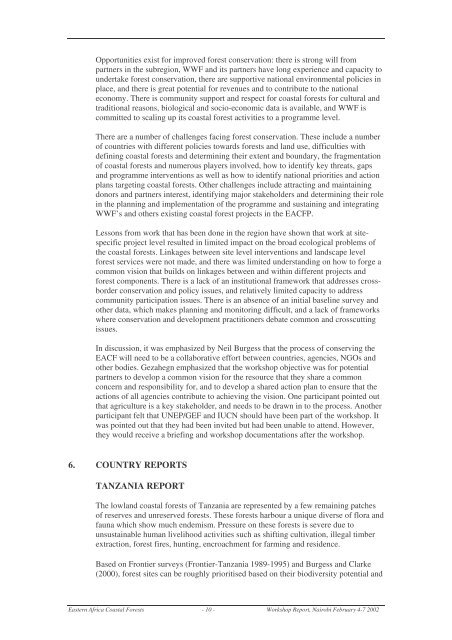Eastern Africa Coastal Forest Programme: Regional Workshop ...
Eastern Africa Coastal Forest Programme: Regional Workshop ...
Eastern Africa Coastal Forest Programme: Regional Workshop ...
You also want an ePaper? Increase the reach of your titles
YUMPU automatically turns print PDFs into web optimized ePapers that Google loves.
Opportunities exist for improved forest conservation: there is strong will from<br />
partners in the subregion, WWF and its partners have long experience and capacity to<br />
undertake forest conservation, there are supportive national environmental policies in<br />
place, and there is great potential for revenues and to contribute to the national<br />
economy. There is community support and respect for coastal forests for cultural and<br />
traditional reasons, biological and socio-economic data is available, and WWF is<br />
committed to scaling up its coastal forest activities to a programme level.<br />
There are a number of challenges facing forest conservation. These include a number<br />
of countries with different policies towards forests and land use, difficulties with<br />
defining coastal forests and determining their extent and boundary, the fragmentation<br />
of coastal forests and numerous players involved, how to identify key threats, gaps<br />
and programme interventions as well as how to identify national priorities and action<br />
plans targeting coastal forests. Other challenges include attracting and maintaining<br />
donors and partners interest, identifying major stakeholders and determining their role<br />
in the planning and implementation of the programme and sustaining and integrating<br />
WWF’s and others existing coastal forest projects in the EACFP.<br />
Lessons from work that has been done in the region have shown that work at sitespecific<br />
project level resulted in limited impact on the broad ecological problems of<br />
the coastal forests. Linkages between site level interventions and landscape level<br />
forest services were not made, and there was limited understanding on how to forge a<br />
common vision that builds on linkages between and within different projects and<br />
forest components. There is a lack of an institutional framework that addresses crossborder<br />
conservation and policy issues, and relatively limited capacity to address<br />
community participation issues. There is an absence of an initial baseline survey and<br />
other data, which makes planning and monitoring difficult, and a lack of frameworks<br />
where conservation and development practitioners debate common and crosscutting<br />
issues.<br />
In discussion, it was emphasized by Neil Burgess that the process of conserving the<br />
EACF will need to be a collaborative effort between countries, agencies, NGOs and<br />
other bodies. Gezahegn emphasized that the workshop objective was for potential<br />
partners to develop a common vision for the resource that they share a common<br />
concern and responsibility for, and to develop a shared action plan to ensure that the<br />
actions of all agencies contribute to achieving the vision. One participant pointed out<br />
that agriculture is a key stakeholder, and needs to be drawn in to the process. Another<br />
participant felt that UNEP/GEF and IUCN should have been part of the workshop. It<br />
was pointed out that they had been invited but had been unable to attend. However,<br />
they would receive a briefing and workshop documentations after the workshop.<br />
6. COUNTRY REPORTS<br />
TANZANIA REPORT<br />
The lowland coastal forests of Tanzania are represented by a few remaining patches<br />
of reserves and unreserved forests. These forests harbour a unique diverse of flora and<br />
fauna which show much endemism. Pressure on these forests is severe due to<br />
unsustainable human livelihood activities such as shifting cultivation, illegal timber<br />
extraction, forest fires, hunting, encroachment for farming and residence.<br />
Based on Frontier surveys (Frontier-Tanzania 1989-1995) and Burgess and Clarke<br />
(2000), forest sites can be roughly prioritised based on their biodiversity potential and<br />
<strong>Eastern</strong> <strong>Africa</strong> <strong>Coastal</strong> <strong>Forest</strong>s - 10 - <strong>Workshop</strong> Report, Nairobi February 4-7 2002
















